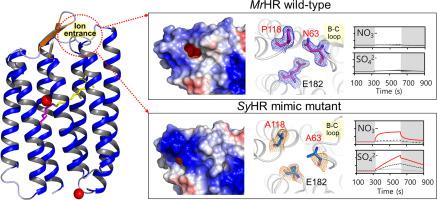Journal of Molecular Biology ( IF 4.7 ) Pub Date : 2020-07-25 , DOI: 10.1016/j.jmb.2020.07.016 Ji-Hye Yun 1 , Jae-Hyun Park 1 , Zeyu Jin 1 , Mio Ohki 2 , Yang Wang 3 , Cecylia Severin Lupala 3 , Haiguang Liu 4 , Sam-Yong Park 2 , Weontae Lee 1

|
Understanding the structure and functional mechanisms of cyanobacterial halorhodopsin has become increasingly important, given the report that Synechocystis halorhodopsin (SyHR), a homolog of the cyanobacterial halorhodopsin from Mastigocladopsis repens (MrHR), can take up divalent ions, such as SO42−, as well as chloride ions. Here, the crystal structure of MrHR, containing a unique “TSD” chloride ion conduction motif, was determined as a homotrimer at a resolution of 1.9 Å. The detailed structure of MrHR revealed a unique trimeric topology of the light-driven chloride pump, with peculiar coordination of two water molecules and hydrogen-mediated bonds near the TSD motif, as well as a short B–C loop. Structural and functional analyses of MrHR revealed key residues responsible for the anion selectivity of cyanobacterial halorhodopsin and the involvement of two chloride ion-binding sites in the ion conduction pathway. Alanine mutant of Asn63, Pro118, and Glu182 locating in the anion inlet induce multifunctional uptake of chloride, nitrate, and sulfate ions. Moreover, the structure of N63A/P118A provides information on how SyHR promotes divalent ion transport. Our findings significantly advance the structural understanding of microbial rhodopsins with different motifs. They also provide insight into the general structural framework underlying the molecular mechanisms of the cyanobacterial chloride pump containing SyHR, the only molecule known to transport both sulfate and chloride ions.
中文翻译:

氰基氯化物泵输送多种阴离子的基于结构的功能修饰研究。
理解蓝藻嗜盐菌紫质的结构和功能的机制已变得日益重要,鉴于报告集胞藻嗜盐菌紫质(SY HR),从蓝藻嗜盐菌紫质的同源物Mastigocladopsis三叶(先生HR),最多可能需要二价离子,如SO 4 2 -以及氯离子。在这里,Mr HR的晶体结构包含一个独特的“ TSD”氯离子传导基序,被确定为均聚物,分辨率为1.9。先生的详细结构HR揭示了光驱氯化物泵的独特三聚体拓扑结构,其中两个水分子和氢介导的键在TSD基序附近以及短的B–C环的特殊配位。对HR先生进行的结构和功能分析显示,主要残基负责蓝藻盐细菌视紫红质的阴离子选择性,并在离子传导途径中涉及两个氯离子结合位点。位于阴离子入口的Asn63,Pro118和Glu182的丙氨酸突变体可诱导氯离子,硝酸根和硫酸根离子的多功能吸收。此外,N63A / P118A的结构提供了有关SyHR促进二价离子转运。我们的发现大大提高了对具有不同基序的微生物视紫红质的结构理解。他们还提供了洞悉包含Sy HR的蓝细菌氯化物泵的分子机制基础的一般结构框架的信息,Sy HR是已知的唯一既能传递硫酸根离子又能传递氯离子的分子。











































 京公网安备 11010802027423号
京公网安备 11010802027423号